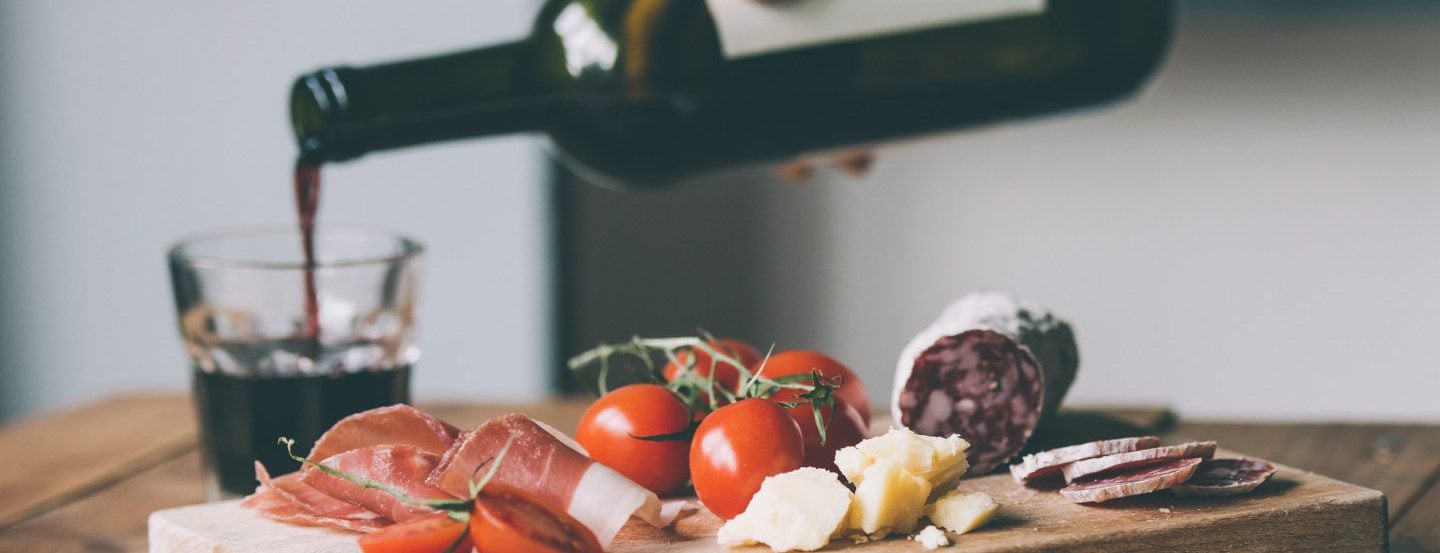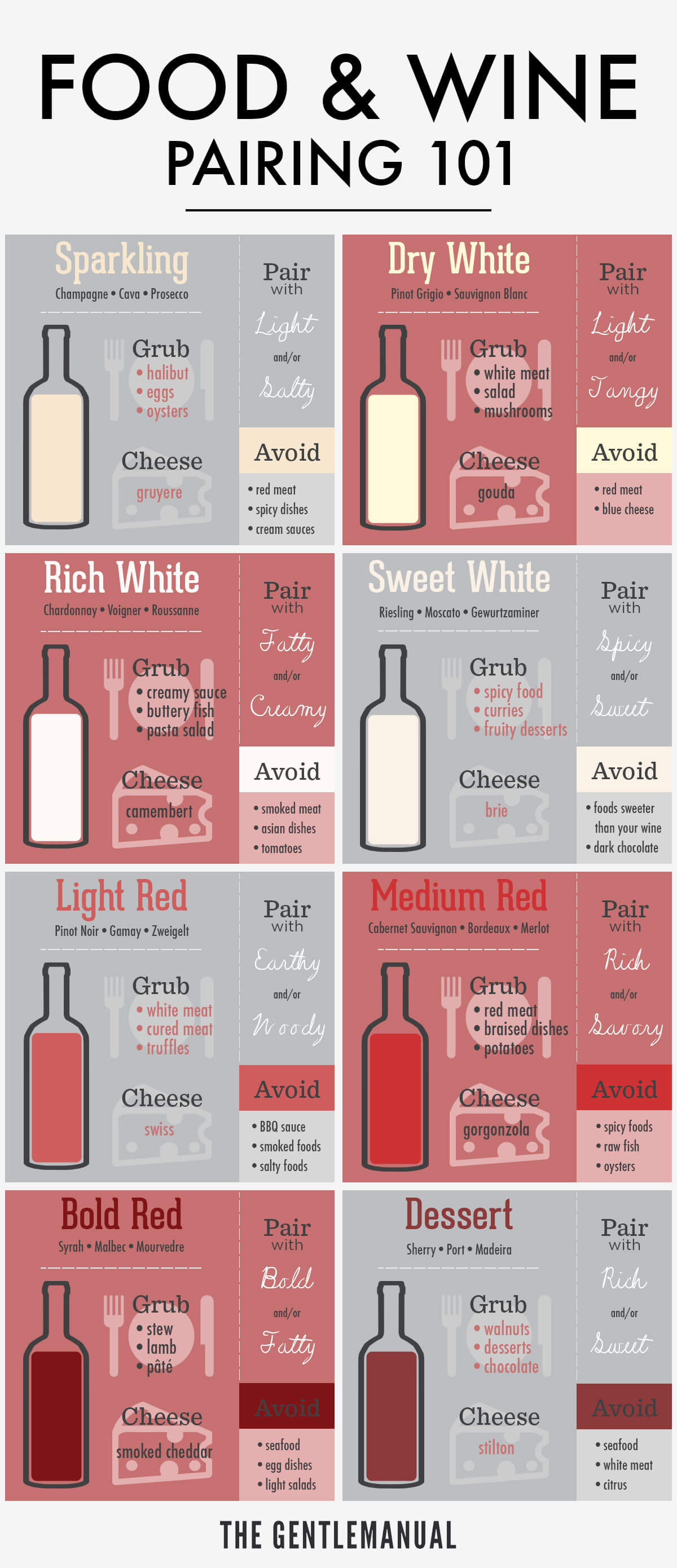How to Pair Wine with Food: A Primer
Don't let matching wine and food leave you feeling glass-half-full

Written by RJ Firchau
You may know the old saying “red with meat, white with fish/poultry.” And sure, there is some truth to that. But that’s just skimming the surface of all the myriad possibilities when it comes to pairing wine and food. Now, you may be starting to conjure up images of that one bottle of cheap red wine you have saved in your pantry for a rainy day, and asking yourself why you need to care about wine pairings when you only ever have 1 bottle on deck.
The simple solution? Buy more wine, build up your palate, and keep reading.
Admittedly, wine and food pairing is a subjective endeavor. What tastes good to you might not taste so great to someone else, and so on and so forth. However, having a little wine pairing knowledge in your back pocket to impress your guests or your date is certainly not a bad move. So, without further ado, here is your wine and food pairing primer.
The Basics of Wine Pairing
Wine pairing is an art form that can be explored for years. If you’re not a cook with Michelin star ambitions or a fancy French restaurant sommelier, you probably only need to be familiar with the basics to get you started.
Rule 1: Aim to Complement, not Overpower
Think of wine as an extra seasoning or spice for your food. Different seasonings will interact differently with your meal, so it’s up to you to season it right. Some flavor pairings are simply destined for one another. Here are a few solid pairing tips:
Rule 2: Match Intensities
If everything else about pairing wine and food trips you up, this is an easy, foolproof rule to live by. When pairing wine and foods, matching the intensity is a quick way of ensuring that one element doesn’t overpower the other. So, match your delicate wines with delicate meals (salad, vegetables, fish, poached eggs), your moderately hearty wines with moderately hearty meals (baked chicken, creamy pasta), and your strong, bold wines with strong, rich meals (braised beef, spicy curry).
Rule 3: Let the Dominant Flavor Guide Your Pairing
If your dish is going to have a lot going on in the flavor department, choose the most outstanding, noticeable flavor and pair that with your wine (so yes, you can drink a red wine with a white meat if the flavor profile demands it).

The Combos: A Failsafe Food and Wine Pairing Chart
Now that you know the basics, where should you start? Think back to that one bottle of wine you have in your pantry. What is it? Read on for some great pairings to help you decide what you should be eating tonight. Use this chart to help you determine what flavor profiles to stick to, what foods and cheeses pair nicely, and what foods to avoid no matter what you’re drinking.

Thirsty for more? Check out our Whiskey and Food Pairing Guide here.
RJ Firchau

Written by RJ Firchau
You may know the old saying “red with meat, white with fish/poultry.” And sure, there is some truth to that. But that’s just skimming the surface of all the myriad possibilities when it comes to pairing wine and food. Now, you may be starting to conjure up images of that one bottle of cheap red wine you have saved in your pantry for a rainy day, and asking yourself why you need to care about wine pairings when you only ever have 1 bottle on deck.
The simple solution? Buy more wine, build up your palate, and keep reading.
Admittedly, wine and food pairing is a subjective endeavor. What tastes good to you might not taste so great to someone else, and so on and so forth. However, having a little wine pairing knowledge in your back pocket to impress your guests or your date is certainly not a bad move. So, without further ado, here is your wine and food pairing primer.
The Basics of Wine Pairing
Wine pairing is an art form that can be explored for years. If you’re not a cook with Michelin star ambitions or a fancy French restaurant sommelier, you probably only need to be familiar with the basics to get you started.
Rule 1: Aim to Complement, not Overpower
Think of wine as an extra seasoning or spice for your food. Different seasonings will interact differently with your meal, so it’s up to you to season it right. Some flavor pairings are simply destined for one another. Here are a few solid pairing tips:
- Acidic foods demand acidic wines
- Fatty foods demand tannins (What are tannins? Find out here)
- Spicy foods demand sweet wines
- Salty foods demand sweet—preferably sparkling—wines
- Sweet foods demand sweeter wines
Rule 2: Match Intensities
If everything else about pairing wine and food trips you up, this is an easy, foolproof rule to live by. When pairing wine and foods, matching the intensity is a quick way of ensuring that one element doesn’t overpower the other. So, match your delicate wines with delicate meals (salad, vegetables, fish, poached eggs), your moderately hearty wines with moderately hearty meals (baked chicken, creamy pasta), and your strong, bold wines with strong, rich meals (braised beef, spicy curry).
Rule 3: Let the Dominant Flavor Guide Your Pairing
If your dish is going to have a lot going on in the flavor department, choose the most outstanding, noticeable flavor and pair that with your wine (so yes, you can drink a red wine with a white meat if the flavor profile demands it).

The Combos: A Failsafe Food and Wine Pairing Chart
Now that you know the basics, where should you start? Think back to that one bottle of wine you have in your pantry. What is it? Read on for some great pairings to help you decide what you should be eating tonight. Use this chart to help you determine what flavor profiles to stick to, what foods and cheeses pair nicely, and what foods to avoid no matter what you’re drinking.

Thirsty for more? Check out our Whiskey and Food Pairing Guide here.
RJ Firchau
SOURCE: THE GENTLEMANUAL
Comments
Post a Comment